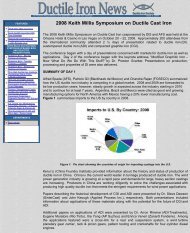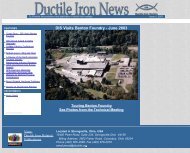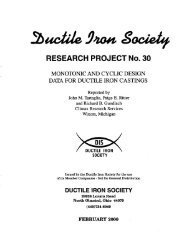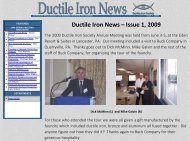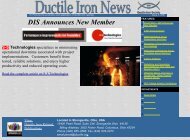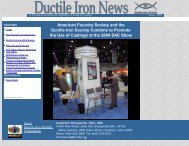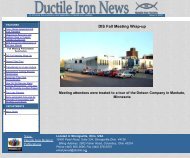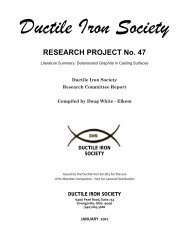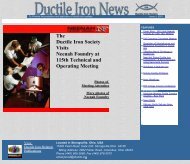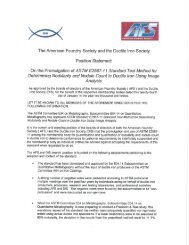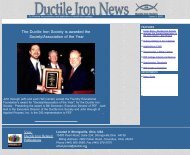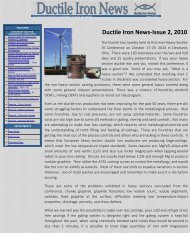Create successful ePaper yourself
Turn your PDF publications into a flip-book with our unique Google optimized e-Paper software.
may offset the actual target/chemical value plus or minus 4 points, resulting in an eight point spread. When the pouring temperature is above 2480<br />
°F, the reported value may offset the target value plus or minus 8 points, or a 16 point spread.<br />
Instead of pouring a tellurium cup to analyze the silicon content, a spectrometer could also be used. This by far is the most accurate way to<br />
measure silicon, but I decided to not go this route because not only was it a slower method, more manpower would be needed to run the<br />
spectrometer. Besides, if our tellurium cups were poured below 2480 °F our silicon value should be at the most 4 points off target. That is<br />
equivalent to only one ACEL point, and obviously better than being off 30 silicon points! Currently our target ACEL range for gray and ductile iron is<br />
3 points total for each.<br />
So looking at it from a different perspective as long as we have our initial ACEL and silicon values and knowing our holding temperature is above<br />
the equilibrium temperature, a change in ACEL throughout the furnace is a change in the carbon (loss if ACEL drops). Again, the rest of the cups<br />
only need to record ACEL for the operator to use the Excel mass balance spreadsheet. Double checking silicon by pouring an extra tellurium cup is<br />
always an option too.<br />
Conclusion<br />
Even with the trouble we experienced with the “active carbon” readings, I believe ATAS is a valuable thermal analysis system that can be used<br />
online at the furnace. I believe the pros numerously outweigh the cons. We saved more than $60,000 in inoculant and FeSiMg consumption alone<br />
during the first year. Not everyone inoculates as heavily as we did to generate some of the savings, but imagine the savings if your foundry were<br />
bigger than ours. In addition by properly inoculating our iron our metallurgical scrap has also reduced.<br />
has impOnce optimization testing has been carried through, I believe using ATAS at the furnace is where is it is needed most. Reducing process<br />
variation upstream has improved our overall quality control downstream.<br />
View<br />
<strong>Ductile</strong> <strong>Iron</strong> Related<br />
Publications<br />
Located in Strongsville, Ohio, USA<br />
15400 Pearl Road, Suite 234; Strongsville,Ohio 44136<br />
Billing Address: 2802 Fisher Road, Columbus, Ohio 43204<br />
Phone (440) 665-3686; Fax (440) 878-0070<br />
email:jwood@ductile.org



